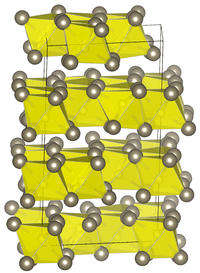Thallium(I) sulfide facts for kids
Quick facts for kids Thallium(I) sulfide |
|
|---|---|
 |
|
| IUPAC name | Thallium(I) sulfide |
| Other names | thallous sulfide, thallous sulphide |
| Identifiers | |
| CAS number | |
| PubChem | |
| EC number | 215-250-8 |
| SMILES | S([Tl])[Tl] |
| Properties | |
| Molecular formula | |
| Molar mass | 0 g mol-1 |
| Appearance | black crystalline solid |
| Density | 8.390 g/cm3 |
| Melting point | |
| Boiling point | |
| −88.8·10−6 cm3/mol | |
| Structure | |
| Crystal structure | Trigonal, hR81 |
| Space group | R3, No. 146 |
| Except where noted otherwise, data are given for materials in their standard state (at 25 °C, 100 kPa) | |
Thallium(I) sulfide, also known as thallous sulfide, is a chemical compound. Its chemical formula is Tl2S. It is made of thallium and sulfide particles called ions. The thallium in it has a +1 electric charge.
What it's Like
Thallium(I) sulfide is a black solid material. When it mixes with acids, it creates two new things. These are hydrogen sulfide gas and a thallium salt. Hydrogen sulfide smells like rotten eggs.
Where it's Found and How it's Made
You can find thallium(I) sulfide in nature. It is a mineral called carlinite. However, carlinite is quite rare. It is the only thallium sulfide mineral that does not contain another metal. Scientists can also make it in a lab. They do this by mixing thallium(I) sulfate with hydrogen sulfide. Another way is to heat thallium and sulfur together.
What it's Used For
This compound was used in some of the very first infrared detectors. These detectors can "see" heat. One of the first reliable infrared detectors used thallium sulfide. It was created during World War II.
Related pages

